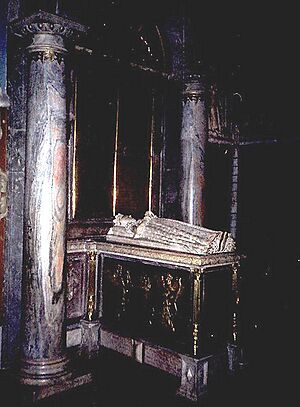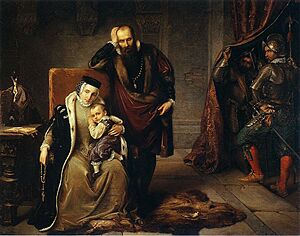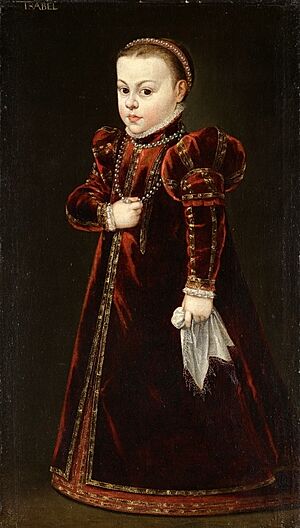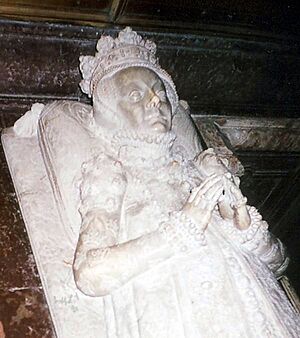Catherine Jagiellon facts for kids
Quick facts for kids Catherine Jagiellon |
|
|---|---|

Portrait by Lucas Cranach the Younger (c. 1556)
|
|
| Queen consort of Sweden | |
| Tenure | 30 September 1568 – 16 September 1583 |
| Born | 1 November 1526 Kraków, Poland |
| Died | 16 September 1583 (aged 56) Stockholm, Sweden |
| Burial | Uppsala Cathedral, Sweden |
| Spouse | |
| Issue |
|
| Dynasty | Jagiellon |
| Father | Sigismund I of Poland |
| Mother | Bona Sforza |
| Religion | Roman Catholicism |
Catherine Jagiellon (Polish: Katarzyna Jagiellonka; Swedish: Katarina Jagellonica, Lithuanian: Kotryna Jogailaitė; 1 November 1526 – 16 September 1583) was a princess from the Polish–Lithuanian Commonwealth. She became Queen of Sweden in 1569 when she married King John III. Catherine was very important in state matters during her husband's rule. She even talked with the Pope about bringing back Catholic practices to Sweden. She was also the mother of Sigismund, who later became King of Poland and Sweden.
Contents
Early Life and Education
Catherine Jagiellon was born in Kraków, Poland. She was the youngest daughter of King Sigismund I the Old of the Polish–Lithuanian Commonwealth and his wife, Bona Sforza from Milan.
Catherine received an excellent education, typical of the Renaissance period. Italian teachers taught her to read, write, and speak Latin, German, and Italian. She also learned conversation, riding, dancing, singing, and playing musical instruments.
After her father died in 1548, Catherine and her unmarried sisters, Anna and Sophia, moved to Masovia with their mother. In 1556, her sister Sophia married and moved to Germany. Her mother also left for Italy. Catherine and Anna then moved to the Palace of Vilnius in Lithuania. Their brother, Sigismund II Augustus of Poland, wanted to make sure there was a royal presence there. They had a happy time in Vilnius, living in a palace influenced by Italian Renaissance culture. Catherine and Anna had their own staff and spent time with the nobility.
Marriage Plans
Catherine was known as the most beautiful of her sisters. However, she married later than most princesses of her time. Her family wanted her to marry someone of very high political importance for Poland. Many marriage proposals were made, but they often involved long talks that didn't lead to anything.
In the 1550s, her brother, King Sigismund II Augustus, wanted an alliance between Poland and Sweden. This was because of growing tensions with the Tsardom of Russia over Livonia. He didn't see religion as a big problem, as Poland was quite tolerant of Protestants then.
In 1560, Ivan the Terrible, the Russian Czar, suggested marrying Catherine. He hoped this would bring peace between Poland and Russia. Catherine's brother liked the idea, and a Russian group visited the Polish court. However, Poland and Russia could not agree on the political terms, so the talks stopped in 1561.
In 1561, Catherine's brother suggested that his sisters, Catherine and Anna, marry King Eric XIV of Sweden's brothers, John and Magnus. John was interested in marrying Catherine. However, Catherine's brother was hesitant to let his younger sister marry before his older sister, Anna.
Later, in October 1561, Duke John of Finland started marriage talks with Catherine on his own. He did this without King Eric XIV's permission. At this time, Sweden and Poland were fighting in the Livonian war. John saw the Polish king as an important ally. He also saw Catherine's inheritance from her Italian mother as valuable for his own plans.
Duchess of Finland
On 4 October 1562, Catherine married Duke John of Finland. The wedding took place in the Lower Castle of Vilnius, Lithuania. John was the second son of Gustav I and the half-brother of the ruling King Eric XIV. John had not received his brother's permission for the marriage. There were already tensions between them because John was pursuing his own foreign policy. The wedding was a Catholic ceremony.
Catherine brought a large group of people and many valuable items with her. She also brought an impressive dowry (wealth given to the husband at marriage). This included silver items, like the first forks used in Finland. She also had hundreds of beautiful clothes made of satin, silk, and velvet. Her group included Poles, Italians, and Germans, like a Polish cook and an Italian wine expert.
The couple made their home in Turku Castle in Turku, Finland. Duke John's actions in Livonia made King Eric XIV declare war on his brother. Eric sent 10,000 soldiers to surround the castle. On 12 August 1563, the castle surrendered. Catherine and John were taken to Sweden and imprisoned in Gripsholm Castle.
King Eric offered to let Catherine return to Poland, but she chose to stay with John in prison. It is said that when the king made the offer, Catherine pointed to her wedding ring. It had the words: Nemo nisi mors ("Nothing but death [shall separate us]"). Catherine was a valuable hostage for Eric. However, because of her, their imprisonment was not too harsh.
King Eric treated Catherine with respect. He allowed her more freedom than John, such as walking around the castle area. He generally granted her requests to make her imprisonment more comfortable. The only thing he denied was access to Catholic priests. She asked for most of her staff to be sent home. She only kept some Polish ladies-in-waiting and her trusted Court dwarf, Dorothea Ostrelska. While imprisoned, Catherine gave birth to her first daughter, Isabella, in 1564 (who died in 1566). Then, her son Sigismund was born in 1566. In October 1567, John and Eric made peace, and the couple was released. Catherine and John seemed to have become very close during their time in prison.
Czar Ivan the Terrible, who had once wanted to marry Catherine, was talking with Eric. He hoped to separate Catherine from John and send her to Russia to marry him. This worried Catherine and her family. This discussion was one reason why the Swedish people became unhappy with King Eric. King Eric agreed to give Catherine to Ivan. However, the Swedish king was removed from power before Catherine could be sent away. Since his brother John became king, the problem disappeared. Catherine was in Vadstena during the rebellion.
Another reason the nobility was against Eric XIV was his marriage to a commoner, Karin Månsdotter. The nobility saw this as an insult. Catherine played a part in the rebellion. She was friends with Ebba Lilliehöök, an influential noblewoman and enemy of Eric. Catherine was also directly asked by Pontus De la Gardie to convince John to join the rebellion against the King. After Stockholm fell, she entered the city in a grand procession on 7 November 1568.
Queen Consort

Catherine was crowned Queen of Sweden in the spring of 1569. Her relationship with John III remained very good throughout her life. She had her own Catholic chapel at court. She also had several Catholics in her personal staff, including monks and priests. This surprised the Protestants.
Despite some controversy about her role in religious policy, Catherine was not personally slandered much. Many people, both Catholics and Protestants, came to her for help. They asked for charity or for her to speak to the king on their behalf. She performed these duties as a queen was expected to. Even her Protestant brother-in-law, the future Charles IX, spoke of her with mild approval. He called her "a Princess full of virtue and piety," even though her faith came from Rome.
Queen Catherine had political influence and advised the king in many areas. This included his foreign policy and his interest in Renaissance art. It's interesting that the king's diplomatic contacts with Catholic powers quickly decreased after her death. Most importantly, she influenced John III's religious policy. She encouraged him to favor Catholicism and the Counter-Reformation. John III even named Catherine as the possible regent of Sweden. This meant she would rule if he died while their son was still a child.
Another important matter was her son Sigismund's right to the Polish throne. She raised both her children in the Catholic faith. This made Sigismund acceptable as a Polish ruler. After her childless brother Sigismund II Augustus died in 1572, Catherine believed her son had a claim to the Polish throne through her. However, after 1569, Poland became a monarchy where kings were elected. This made her important internationally.
In 1582, she welcomed the former queen, Karin Månsdotter. Catherine made sure that Karin's confiscated jewelry was returned to her.
In her last years, Catherine suffered from gout. She became ill in the spring of 1583. She died in Stockholm on 16 September 1583. She was buried in the royal crypt of the Uppsala Cathedral.
Religious Influence
After becoming queen, Catherine gained international attention. She was a Catholic queen in a Protestant country. People saw her as someone who could bring back the Counter-Reformation. In Rome, the Pope's court saw her as a Catholic surrounded by non-Catholics.
The same year she became queen, her Polish advisor encouraged her to convert John III to Catholicism. She said she was willing, but that the king and the public would not accept it. She later contacted the Pope's court directly.
Queen Catherine supported the old Vadstena Abbey, where the last nuns still lived. She often visited it. A new shrine was made for the relics of King Eric the Saint in the cathedral of Uppsala.
Her efforts to bring back Catholic practices caused tension. This was especially true with the imprisoned Eric XIV, who became a symbol of Protestantism. During Eric's imprisonment, there were several plots to remove John III from power. At least one of these plots was strongly influenced by religious reasons.
Legacy
Catherine's family connection to the Swedish royal line caused a lot of conflict after her death. This was especially true during the European wars of religion. Her son Sigismund inherited the thrones of both the Polish–Lithuanian Commonwealth (in 1587) and Sweden (in 1592). However, he ruled Sweden for only seven years before being removed from power in 1599. Sigismund and his descendants, as Catholic kings, continued to claim the throne of Protestant Sweden for the next century. This dispute led to several destructive wars. A massive Swedish invasion in the 1650s, known as the Deluge, almost destroyed the Polish–Lithuanian Commonwealth. Polish claims to the Swedish throne were finally given up in the 1660 Treaty of Oliva.
Catherine Jagiellon's image became popular again in 19th and 20th century Finnish culture and art. John and Catherine were the only Swedish monarchs to live in the Finnish part of the Swedish realm for a long time. Their supposed love for the land inspired Finnish nationalists. The religious issues that made Catherine unpopular in her own time were no longer important. Instead, she became known as a caring and loyal queen.
The first version of the famous royal Drottningholm Palace (The Queen's Islet) was built for and named after her.
See also
 In Spanish: Catalina Jagellón para niños
In Spanish: Catalina Jagellón para niños
- List of Swedish monarchs
- History of Poland (1385–1569)




